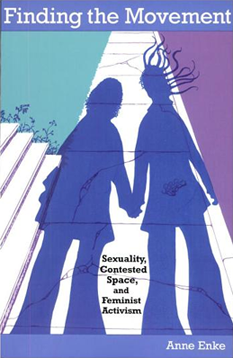Women's Advocates
588 Grand Avenue, St. Paul, MN (1974-2010)
| Information for this page is a summary of Anne Enke's extensive research on the shelter, availible in pages 181-196 of Finding the Movement: Sexuality, Contested Space, and Feminist Activism.
|
Cover of "Finding the Movement: Sexuality, Contested Space, and Feminist Activism."by Anne Enke. Cover designed by Jennifer Hill. |
This changed as time progressed—the shelter switched from volunteers to paid and trained staff, who made a well-reasoned decision to “open up” the house, both physically and by advertising themselves in local papers.(5)
Another change led to Women’s Advocates significance to local queer history. By 1978, the shelter had to revise its understanding of abusive relationships. Men were long considered the perpetrators of violence—feminists blamed patriarchal society for the mistreatment of women in battering relationships. When presented with instances of abuse inflicted in lesbian partnerships, the women had to revise their thinking.(6) To date, the organization offers service for female victims of domestic abuse, regardless of their partner's gender.(7)
(1)Enke, Anne. Finding the Movement: Sexuality, Contested Space, and Feminist Activism. North Carolina: Duke University Press, 2007. Page 183.
(2) Ibid.
(3) Enke, pages 183, 197, and 188.
(4) Enke, page 189.
(5) Enke, page 195.
(6) Enke, pages 195-196.
(7) http://www.wadvocates.org/index.asp?Type=B_BASIC&SEC={9E25BB8C-2CDA-427E-89FB-B18AECFF4DAE}
Part of Minneapolis/St. Paul, MN: 100 Queer Places in Minnesota History, (1860-1969), (1969-2010)
